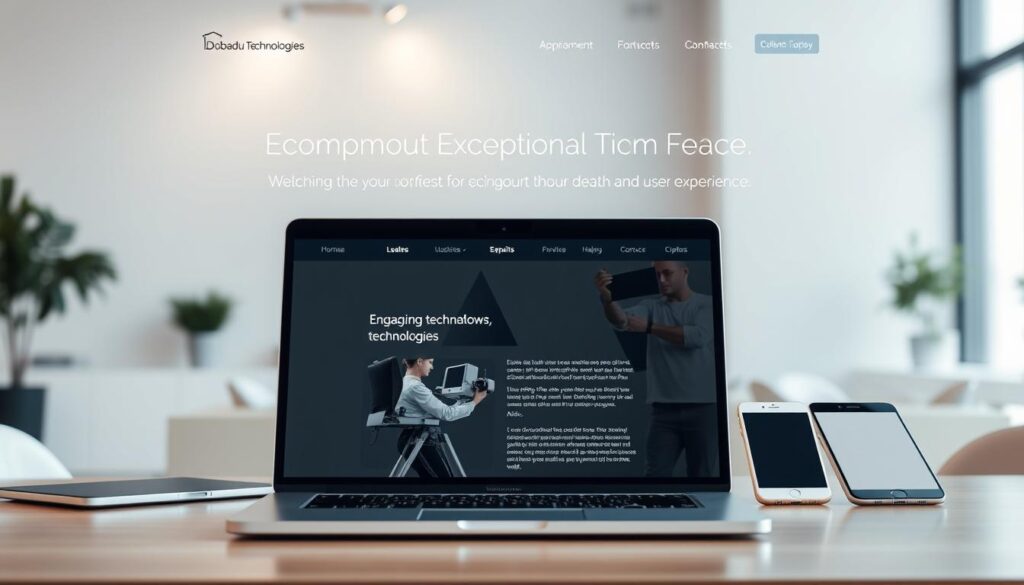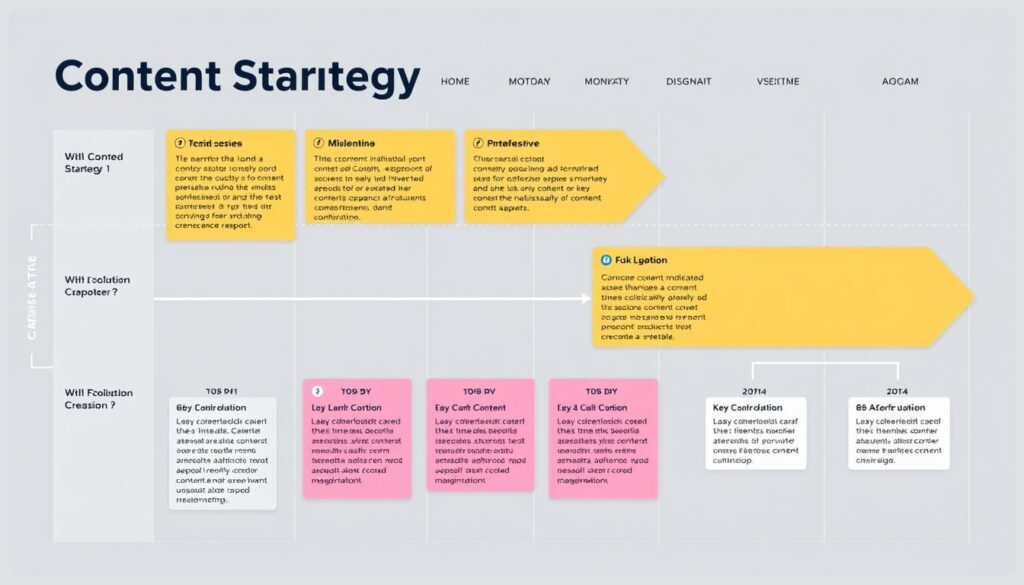As content marketers, we understand that content creation is our most time-consuming responsibility. It’s our chief task to engage with our audience and influence revenue through high-quality content.
Creating a professional website requires a comprehensive process that goes beyond just writing text. It involves strategic planning, understanding our audience, and purposeful execution to drive meaningful results for our brand and marketing efforts.
By transforming our website into a powerful engagement tool, we can achieve our digital marketing goals. In this article, we’ll explore the fundamental concepts that make this possible.
Key Takeaways
- Understanding the importance of quality content in digital marketing
- Transforming a website into a powerful engagement tool
- The role of strategic planning in content creation
- The significance of audience understanding in content creation
- Purposeful execution for driving meaningful results
Understanding the Power of Website Content
Effective website content is essential for capturing and retaining the attention of your target audience. It serves as the foundation upon which a successful online presence is built.

What Defines Website Content Creation
Website content creation involves producing high-quality, engaging content that resonates with your audience. This includes informative articles, compelling visuals, and intuitive navigation that work together to provide a seamless user experience.
Quality content is not just about conveying information; it’s about doing so in a way that is engaging, accessible, and relevant to your audience’s needs.
Why Quality Content Matters for User Experience
Quality content directly impacts user experience by providing value, answering questions, and solving problems. When content is well-crafted, it builds trust and credibility with your audience, establishing your brand as an authority in your industry.
Research has shown that creating quality educational content makes customers 131% more likely to buy from your business. This underscores the importance of prioritizing quality in your content creation efforts.
Furthermore, search engines prioritize quality content in their algorithms, making it essential for visibility and traffic. By focusing on quality, you can improve key business metrics like time on site, bounce rates, and conversion rates.
The Foundation of Effective Website Content Creation
The key to successful website content lies in understanding the fundamental principles that drive its creation. A well-planned website content creation strategy is vital for businesses to connect with their audience and achieve their marketing goals.

Setting Clear Content Goals and Objectives
Establishing clear content goals and objectives is the first step towards creating effective website content. This involves defining what you want to achieve through your content, whether it’s to educate, entertain, or persuade your audience. By setting specific, measurable goals, you can develop a focused content strategy that drives results for your business and enhances your brand presence.
Clear goals help in creating content that is aligned with your overall marketing strategy, ensuring that every piece of content serves a purpose and contributes to achieving your objectives.
Identifying Your Target Audience
Understanding your target audience is crucial for creating content that resonates with them. When you write for a specific ideal customer profile (ICP), you increase your chances of resonating with them than if you threw them into the general profile cluster. Consequently, they become marketers of your content and service free of charge.
To identify your target audience, we’ll outline methods for developing detailed audience personas that capture demographics, psychographics, pain points, and content preferences. Understanding your people and their needs is key to creating content that engages and converts.
- We’ll explain how understanding your audience’s needs, challenges, and questions should drive your content creation decisions.
- We’ll discuss techniques for audience research including surveys, interviews, social listening, and analytics review.
- We’ll highlight the importance of creating content for specific audience segments rather than trying to appeal to everyone.
- We’ll demonstrate how audience-centric content leads to higher engagement, sharing, and ultimately conversion rates.
By focusing on your target people and creating content that speaks to them, you can establish a strong connection and drive meaningful interactions with your brand.
Content Ideation: Where Great Website Content Begins
The journey to creating impactful website content begins with a well-thought-out content ideation process. This initial step is crucial as it lays the foundation for all subsequent content creation efforts. Effective content ideation involves understanding your audience, analyzing your competition, and identifying gaps in the current content landscape.
Keyword Research Techniques
Keyword research is a fundamental aspect of content ideation. It involves using various tools and techniques to identify relevant keywords and phrases that your target audience uses when searching for information related to your topic. By incorporating these keywords into your content, you can improve your website’s visibility in search engine results. For more ideas on how to generate content, you can visit content ideas.
Customer Feedback as Content Inspiration
Another valuable source of content inspiration is customer feedback. By listening to your customers’ concerns, questions, and suggestions, you can identify areas where you can create content that addresses their needs. This not only helps in creating relevant content but also enhances customer engagement and trust in your brand.
Competitive Analysis for Content Ideas
Understanding how your competitors approach a topic will help you differentiate your brand’s voice, approach, and content from theirs. By analyzing their content strategy, you can identify gaps in their approach and opportunities to stand out. This involves evaluating the quality, depth, format, and audience engagement of their content, as well as identifying topics they have overlooked or haven’t covered adequately.

Developing Your Content Strategy
A well-crafted content strategy serves as the backbone of any successful digital marketing effort. It guides the creation, publication, and management of content across all media and channels.
To develop an effective content strategy, we need to consider several key factors, including the type of content, the target audience, and the overall marketing goals.
Content Types and Formats
Understanding the various content types and formats is crucial for creating a diverse and engaging content mix. This includes blog posts, videos, social media posts, podcasts, and more.
Different formats serve different purposes and cater to different audience preferences. For instance, blog posts are great for in-depth information, while videos can be more engaging for demonstrating products or services.
Creating a Content Calendar
A content calendar is an essential tool for planning and organizing your content creation process. It helps ensure consistency and efficiency in your content publication schedule.
To create a content calendar, we need to determine the time required for each stage of the content creation process, from ideation to publication. This involves planning and allocating appropriate time for research, writing, editing, and publishing.
An effective content calendar should balance timely, seasonal content with evergreen pieces that provide long-term value. It should also align with marketing campaigns, product launches, and business objectives.
- Outline the essential components of an effective content calendar.
- Discuss how to balance timely content with evergreen pieces.
- Explain strategies for maintaining consistent publishing schedules.
The Website Content Creation Process
Creating compelling website content is a multi-step process that requires careful planning, development, and distribution to achieve maximum impact. This process is crucial for engaging the target audience and driving significant organic traffic to your website.
Step 1: Research and Planning
The first step involves thorough research and planning. This includes understanding your target audience, identifying relevant keywords, and analyzing competitors. Effective research lays the foundation for content that resonates with your audience and stands out in search engine results.
Step 2: Content Development
In the second step, you develop your content based on the insights gathered during research and planning. This involves creating high-quality, engaging content that meets the needs of your audience. It’s essential to focus on clarity, coherence, and relevance during this phase.
Step 3: Review and Editing
The third step is reviewing and editing your content. This ensures that the content is free from errors, flows smoothly, and maintains a consistent tone. Reviewing and editing are critical for enhancing the quality and credibility of your content.
Step 4: Publishing and Distribution
The final step involves publishing your content on your website and distributing it across various channels. Effective distribution strategies include leveraging social media, email marketing, and other media to promote your content. Timing your publication and using internal linking and site architecture can significantly enhance your content’s reach and engagement.
To illustrate the content creation process more clearly, here’s a summary in a tabular format:
| Step | Description | Key Activities |
|---|---|---|
| 1. Research and Planning | Understanding audience and competitors | Keyword research, audience analysis |
| 2. Content Development | Creating high-quality content | Writing, designing, and producing content |
| 3. Review and Editing | Ensuring content quality | Proofreading, editing, and revising |
| 4. Publishing and Distribution | Reaching the target audience | Content publishing, social media promotion, email marketing |
By following these steps and utilizing a multi-channel distribution strategy, you can significantly enhance the visibility and impact of your website content.
Creating Content That Engages Your Audience
Crafting content that resonates with your audience is crucial for a successful online presence. To achieve this, we need to understand what makes content engaging and how to incorporate those elements into our strategy.
Storytelling Techniques
Storytelling is a powerful tool in content creation. It allows us to connect with our audience on an emotional level, making our content more relatable and memorable. By using narratives, anecdotes, and metaphors, we can convey complex information in a more digestible and engaging way. Effective storytelling can increase audience engagement and encourage sharing, which is vital for expanding our online reach.
To incorporate storytelling into our content, we should:
- Identify our audience’s interests and preferences
- Use real-life examples or case studies
- Create a narrative arc that captures attention and maintains interest
Visual Elements That Enhance Engagement
Visual content plays a significant role in enhancing audience engagement. By incorporating visual elements such as images, infographics, charts, videos, and interactive content, we can make our content more appealing and accessible. Visuals help to break up text, illustrate complex concepts, and capture the audience’s attention.
To maximize the impact of visual elements, we should:
- Use high-quality, relevant images that support our content
- Create informative and engaging infographics
- Incorporate videos and interactive elements to enhance user experience
By combining effective storytelling techniques with strategic use of visual elements, we can create content that truly engages our audience and fosters a loyal following.
SEO Best Practices for Website Content

As we navigate the complexities of online content creation, understanding SEO best practices becomes increasingly important. Creating content that resonates with your audience and ranks well on search engines is a delicate balance. At its core, SEO is about enhancing the quality and relevance of your website content to make it more discoverable by search engines.
When it comes to SEO, the strength, relevancy, and value of your content are critical. If you create content that satisfies your users’ needs, it’s beneficial for search engines because it aligns with their goal of providing users with the most relevant and valuable information.
On-Page SEO Elements
On-page SEO elements are crucial for improving your website’s visibility on search engines. These include optimizing meta tags, titles, and descriptions, as well as using header tags (H1, H2, H3, etc.) to structure your content. Additionally, ensuring that your content is mobile-friendly and has fast loading speeds is vital, as these are now key ranking factors.
By focusing on these on-page SEO elements, you can significantly improve your website’s search engine rankings and drive more traffic to your site.
User Experience and SEO Connection
There’s a significant connection between user experience and SEO. Search engines now prioritize websites that offer a good user experience, as indicated by metrics such as time on page, bounce rate, and click-through rate. Creating content that is engaging, accessible, and easy to navigate not only improves user experience but also enhances your SEO performance.
By understanding and leveraging this connection, you can create a user-centered content strategy that naturally aligns with search engine algorithms, thereby improving your website’s visibility and ranking.
Content Governance: Maintaining Quality and Consistency
To ensure consistency and quality, implementing a robust content governance framework is essential. Content governance encompasses the processes, policies, and guidelines that govern the creation, publication, and maintenance of content across an organization.
Effective content governance is critical for maintaining the integrity and coherence of your content. It helps in standardizing the content creation process, ensuring that all content meets the desired quality and consistency standards.
Developing Style Guides and Editorial Guidelines
A well-developed style guide and editorial guidelines are foundational elements of content governance. These documents outline the tone, voice, and language usage for all content, ensuring that it resonates with the target audience and aligns with the brand’s identity.
By establishing clear guidelines, we can maintain consistency in content style and tone, making it easier for readers to recognize and engage with our brand.
Content Templates and Workflows
Content templates are invaluable assets that guarantee consistency and save time in conforming content to the desired format. For instance, using a template for blog posts ensures that writers produce consistent content without missing essential elements.
Documented workflows clarify responsibilities and timelines throughout the content creation process. By implementing approval processes, we can maintain quality without creating bottlenecks.
| Content Type | Template Benefits | Workflow Advantages |
|---|---|---|
| Blog Posts | Consistent structure, essential elements included | Clear responsibilities, timely publication |
| Product Pages | Standardized product information, improved SEO | Efficient review and approval process |
| Social Media Posts | Uniform tone and style, brand recognition | Streamlined content calendar management |
By leveraging content templates and workflows, we can scale our content production while maintaining consistent quality. This enables us to efficiently manage our content creation process, ensuring that our content remains engaging and relevant to our audience.
Content Production Tools Worth Exploring
In the realm of content creation, having the right tools can make a significant difference in the quality and effectiveness of your content. To maximize your content’s potential, it’s crucial to explore and utilize the best tools available.

Content Management Systems
A robust Content Management System (CMS) is the backbone of any content-driven website. Popular CMS options like WordPress and Drupal offer flexibility, scalability, and a wide range of plugins to enhance your content management capabilities.
Collaboration and Workflow Tools
Effective collaboration is key to producing high-quality content. Tools like Trello and Asana help streamline workflows, assign tasks, and track progress, ensuring that your content team works efficiently.
SEO and Analytics Tools
To measure the success of your content, you need to monitor its performance using SEO and analytics tools. Google Search Console and Conductor are invaluable resources that provide insights into your content’s search engine rankings, organic traffic, and areas for improvement.
By leveraging these tools, you can refine your content strategy, improve your search visibility, and drive more traffic to your website.
Measuring Content Performance
Measuring content performance is essential for evaluating its impact on our audience. By establishing a set list of KPIs and measuring our content ROI, we’ll be able to prove the value of our content efforts and gain additional buy-in for future initiatives.
Key Metrics to Track
To effectively measure content performance, we need to identify and track the right metrics. These may include engagement metrics such as time on page, bounce rate, and social shares, as well as conversion metrics like form submissions or sales generated from the content.
| Metric | Description | Importance |
|---|---|---|
| Time on Page | Average time spent on a page | High |
| Bounce Rate | Percentage of visitors who leave immediately | High |
| Conversion Rate | Percentage of visitors who complete a desired action | High |
Using Analytics to Improve Content
Analytics play a crucial role in improving our content. By analyzing performance data, we can identify areas for improvement and opportunities to optimize our content for better engagement and conversion. We can use analytics to inform A/B testing methodologies and refine content elements to improve performance.
By leveraging data insights, we can create a feedback loop that continuously enhances our content quality over time.
Common Content Creation Mistakes to Avoid
Content creation is a nuanced process, and being aware of potential mistakes can help you navigate it more effectively. A well-crafted content strategy is essential for engaging your audience and achieving your goals. However, several common pitfalls can undermine your efforts.
One of the most significant mistakes is trying to appeal to everyone, rather than targeting a specific audience. This can lead to content that is too broad and fails to resonate with anyone.
Writing for Everyone Instead of Someone
When you try to write for everyone, your content can become generic and lack a clear voice. Instead, identify your target audience and tailor your content to their needs and interests. This will help you create more focused and effective content.
Neglecting Content Distribution
Creating great content is only half the battle; you also need to ensure it reaches your target audience. Neglecting content distribution can lead to poor visibility and engagement. Develop a distribution strategy that includes social media, email newsletters, and other relevant channels.
Changing Too Many Elements at Once
When making changes to your content strategy, it’s essential to do so in a controlled and incremental manner. Changing too many elements at once can make it difficult to determine what is working and what isn’t. Instead, make data-driven changes and test them methodically to identify what truly works.
Some key considerations when making changes to your content strategy include:
- Making incremental changes to allow for proper performance attribution and learning
- Prioritizing content improvements based on potential impact and implementation effort
- Testing content changes methodically to identify what truly works
- Maintaining consistency in some elements while testing others to create a more reliable feedback loop
By avoiding these common mistakes and being mindful of your content strategy, you can create more effective content that resonates with your audience and drives results over time.
Scaling Your Website Content Creation
With the digital landscape constantly shifting, businesses need to scale their content creation efforts to remain relevant. As companies grow, their content needs evolve, requiring a strategic approach to content production.
Scaling content creation involves making informed decisions about how to produce high-quality content efficiently. This can be achieved by either building an in-house content team or outsourcing to external agencies or freelancers.
Building a Content Team
Developing an in-house content team allows for greater control over the content creation process. This approach enables businesses to align their content closely with their brand voice and messaging. A dedicated team can also foster a deeper understanding of the company’s products and services, leading to more nuanced and effective content.
However, building a content team requires significant investment in talent acquisition, training, and infrastructure. It’s essential to weigh these costs against the benefits of having a dedicated team.
Outsourcing vs. In-House Content Creation
Outsourcing content creation can provide access to a broader range of skills and expertise, allowing businesses to produce high-quality content without the need for extensive in-house resources. Agencies and freelancers can bring fresh perspectives and specialized knowledge to content projects.
| Content Creation Approach | Advantages | Challenges |
|---|---|---|
| In-House | Greater control, brand alignment | High costs, resource-intensive |
| Outsourcing | Access to expertise, cost-effective | Quality control, brand consistency |
| Hybrid Model | Flexibility, optimized resource use | Coordination challenges, potential duplication of efforts |
When deciding between in-house content creation and outsourcing, businesses should consider factors such as cost, quality, and the need for specialized expertise. A hybrid model, combining internal and external resources, can also be an effective strategy for scaling content creation.
By carefully evaluating these options and considering the unique needs of their business, companies can develop a content creation strategy that supports their growth and engagement goals.
Content Creation Ideas for Inspiration
In the world of content creation, staying inspired and generating new ideas is vital. We continually seek innovative approaches to captivate our audience and maintain a competitive edge.
One effective strategy is to focus on answering common questions that your audience frequently asks. This not only provides value but also positions your brand as a trusted resource.
Answering Common Questions
By identifying and addressing common queries through blog posts or video content, you can create a repository of helpful information that resonates with your audience.
Educational Content That Teaches
Developing educational content that teaches your audience something new is another powerful approach. This can be achieved through tutorials, guides, or informative articles shared across various social media platforms.
Repurposing Successful Content
Repurposing successful content is a savvy way to breathe new life into existing material. For instance, turning a popular blog post into a video or infographic can help reach different segments of your audience and maximize your content’s potential across various media channels.
By implementing these strategies, we can ensure a consistent flow of fresh and engaging content that inspires our audience and drives results.
Conclusion
As we’ve seen throughout this article, successful website content creation hinges on a combination of strategic planning, creativity, and ongoing refinement. Creating valuable content that drives relevant traffic to your site is a complex task that requires hours of planning and research to ensure it speaks to the topics and answers the questions your audience is interested in.
In summary, we’ve covered the key principles of effective website content creation, including setting clear goals, understanding your target audience, and developing a content strategy that aligns with your business objectives. We’ve also explored the importance of content ideation, creation, and governance, as well as the role of SEO best practices in enhancing your content’s visibility.
Content creation is not a one-time effort but an ongoing process of creation, measurement, and refinement. To achieve meaningful business results, it’s essential to focus on creating high-quality, audience-focused content that resonates with your target audience. We encourage you to start implementing these practices incrementally, focusing on continuous improvement rather than perfection.
By investing in quality content creation, you’re building long-term assets that continue to deliver value to both your audience and your brand. This strategic approach to content will ultimately drive marketing success and contribute to the growth of your business.
In conclusion, a well-planned content strategy is crucial for engaging your audience and driving business results. By following the principles outlined in this article, you can create a robust website content creation process that supports your business goals and fosters long-term success.






